Quick filters:
Mercury atlas liftoff Stock Photos and Images
 Test launch of the Mercury Atlas rocket blasts off from the Kennedy Space Center April 25, 196 in Cape Canaveral, Florida. The Mercury-Atlas vehicle was destroyed by Range Safety Officer about 40 seconds after liftoff as the test was successful. Stock Photohttps://www.alamy.com/image-license-details/?v=1https://www.alamy.com/stock-photo-test-launch-of-the-mercury-atlas-rocket-blasts-off-from-the-kennedy-102929660.html
Test launch of the Mercury Atlas rocket blasts off from the Kennedy Space Center April 25, 196 in Cape Canaveral, Florida. The Mercury-Atlas vehicle was destroyed by Range Safety Officer about 40 seconds after liftoff as the test was successful. Stock Photohttps://www.alamy.com/image-license-details/?v=1https://www.alamy.com/stock-photo-test-launch-of-the-mercury-atlas-rocket-blasts-off-from-the-kennedy-102929660.htmlRMFYCRR8–Test launch of the Mercury Atlas rocket blasts off from the Kennedy Space Center April 25, 196 in Cape Canaveral, Florida. The Mercury-Atlas vehicle was destroyed by Range Safety Officer about 40 seconds after liftoff as the test was successful.
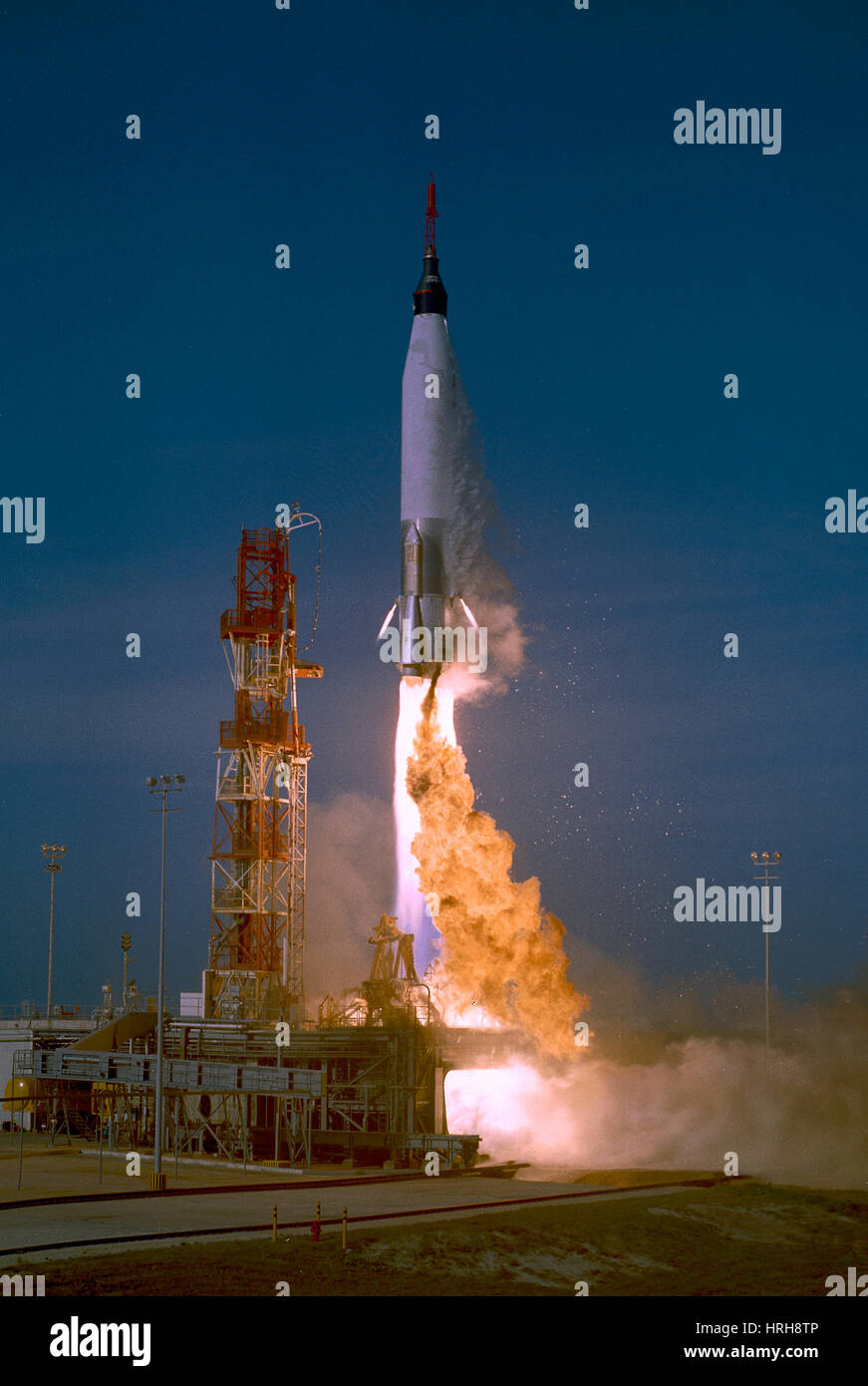 Mercury-Atlas Capsule Test Stock Photohttps://www.alamy.com/image-license-details/?v=1https://www.alamy.com/stock-photo-mercury-atlas-capsule-test-134989814.html
Mercury-Atlas Capsule Test Stock Photohttps://www.alamy.com/image-license-details/?v=1https://www.alamy.com/stock-photo-mercury-atlas-capsule-test-134989814.htmlRMHRH8TP–Mercury-Atlas Capsule Test
 The Mercury-Atlas rocket blasts off from Pad 14 carrying the friendship 7 space capsule carrying astronaut John Glenn at the Kennedy Space Center February 20, 1962 in Cape Canaveral, Florida. Glenn is the first American to fly a manned orbital space flight. Stock Photohttps://www.alamy.com/image-license-details/?v=1https://www.alamy.com/stock-photo-the-mercury-atlas-rocket-blasts-off-from-pad-14-carrying-the-friendship-97279418.html
The Mercury-Atlas rocket blasts off from Pad 14 carrying the friendship 7 space capsule carrying astronaut John Glenn at the Kennedy Space Center February 20, 1962 in Cape Canaveral, Florida. Glenn is the first American to fly a manned orbital space flight. Stock Photohttps://www.alamy.com/image-license-details/?v=1https://www.alamy.com/stock-photo-the-mercury-atlas-rocket-blasts-off-from-pad-14-carrying-the-friendship-97279418.htmlRMFJ7CTX–The Mercury-Atlas rocket blasts off from Pad 14 carrying the friendship 7 space capsule carrying astronaut John Glenn at the Kennedy Space Center February 20, 1962 in Cape Canaveral, Florida. Glenn is the first American to fly a manned orbital space flight.
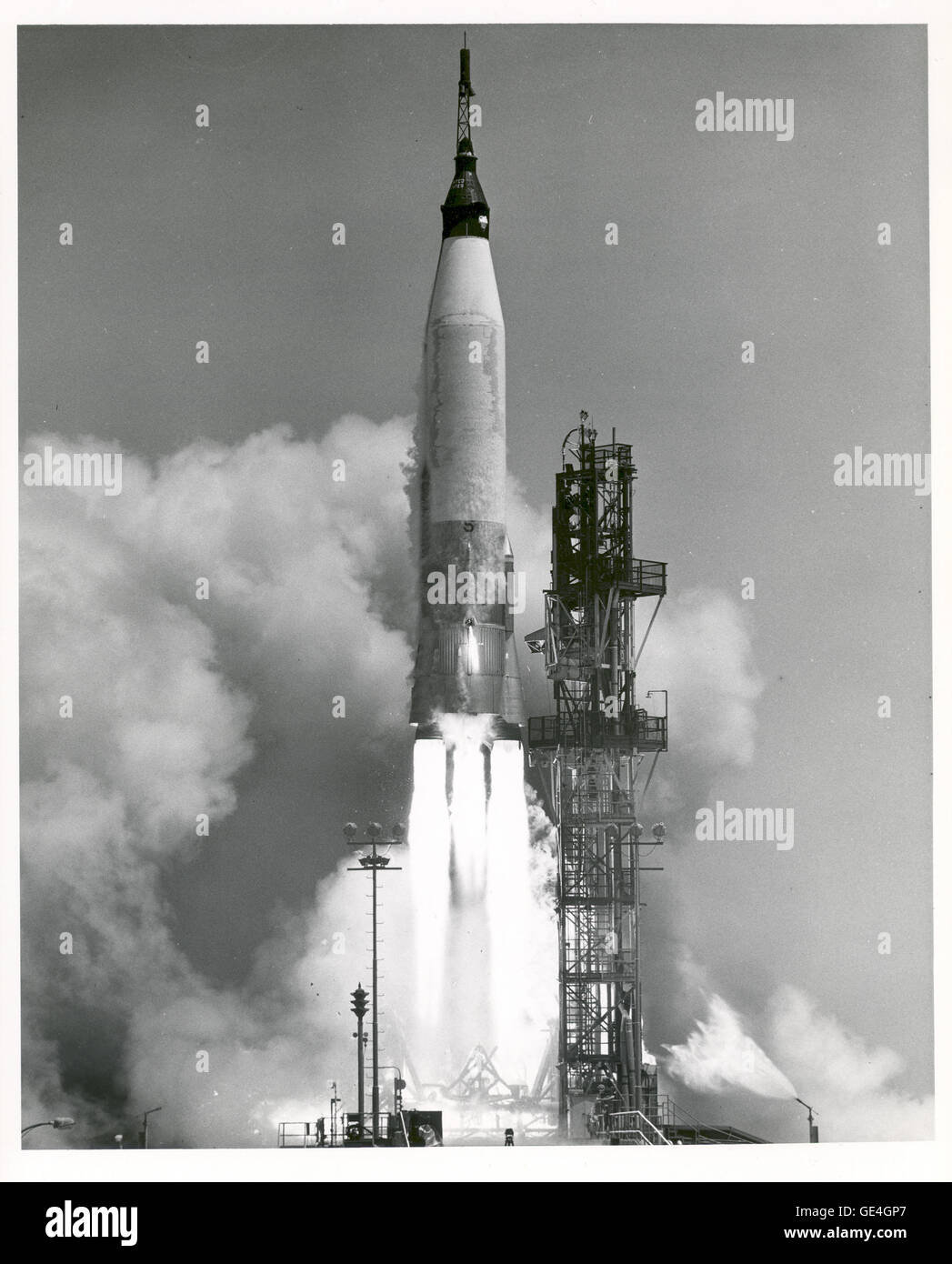 A NASA Project Mercury spacecraft was test launched at 11:15 AM EST on April 25, 1961 from Cape Canaveral, Florida, in a test designed to qualify the Mercury Spacecraft and all systems, which must function during orbit and reentry from orbit. The Mercury-Atlas vehicle was destroyed by Range Safety Officer about 40 seconds after liftoff. The spacecraft was recovered and appeared to be in good condition. Atlas was designed to launch payloads into low Earth orbit, geosynchronous transfer orbit or geosynchronous orbit. NASA first launched Atlas as a space launch vehicle in 1958. Image # : Mercur Stock Photohttps://www.alamy.com/image-license-details/?v=1https://www.alamy.com/stock-photo-a-nasa-project-mercury-spacecraft-was-test-launched-at-1115-am-est-111968367.html
A NASA Project Mercury spacecraft was test launched at 11:15 AM EST on April 25, 1961 from Cape Canaveral, Florida, in a test designed to qualify the Mercury Spacecraft and all systems, which must function during orbit and reentry from orbit. The Mercury-Atlas vehicle was destroyed by Range Safety Officer about 40 seconds after liftoff. The spacecraft was recovered and appeared to be in good condition. Atlas was designed to launch payloads into low Earth orbit, geosynchronous transfer orbit or geosynchronous orbit. NASA first launched Atlas as a space launch vehicle in 1958. Image # : Mercur Stock Photohttps://www.alamy.com/image-license-details/?v=1https://www.alamy.com/stock-photo-a-nasa-project-mercury-spacecraft-was-test-launched-at-1115-am-est-111968367.htmlRMGE4GP7–A NASA Project Mercury spacecraft was test launched at 11:15 AM EST on April 25, 1961 from Cape Canaveral, Florida, in a test designed to qualify the Mercury Spacecraft and all systems, which must function during orbit and reentry from orbit. The Mercury-Atlas vehicle was destroyed by Range Safety Officer about 40 seconds after liftoff. The spacecraft was recovered and appeared to be in good condition. Atlas was designed to launch payloads into low Earth orbit, geosynchronous transfer orbit or geosynchronous orbit. NASA first launched Atlas as a space launch vehicle in 1958. Image # : Mercur
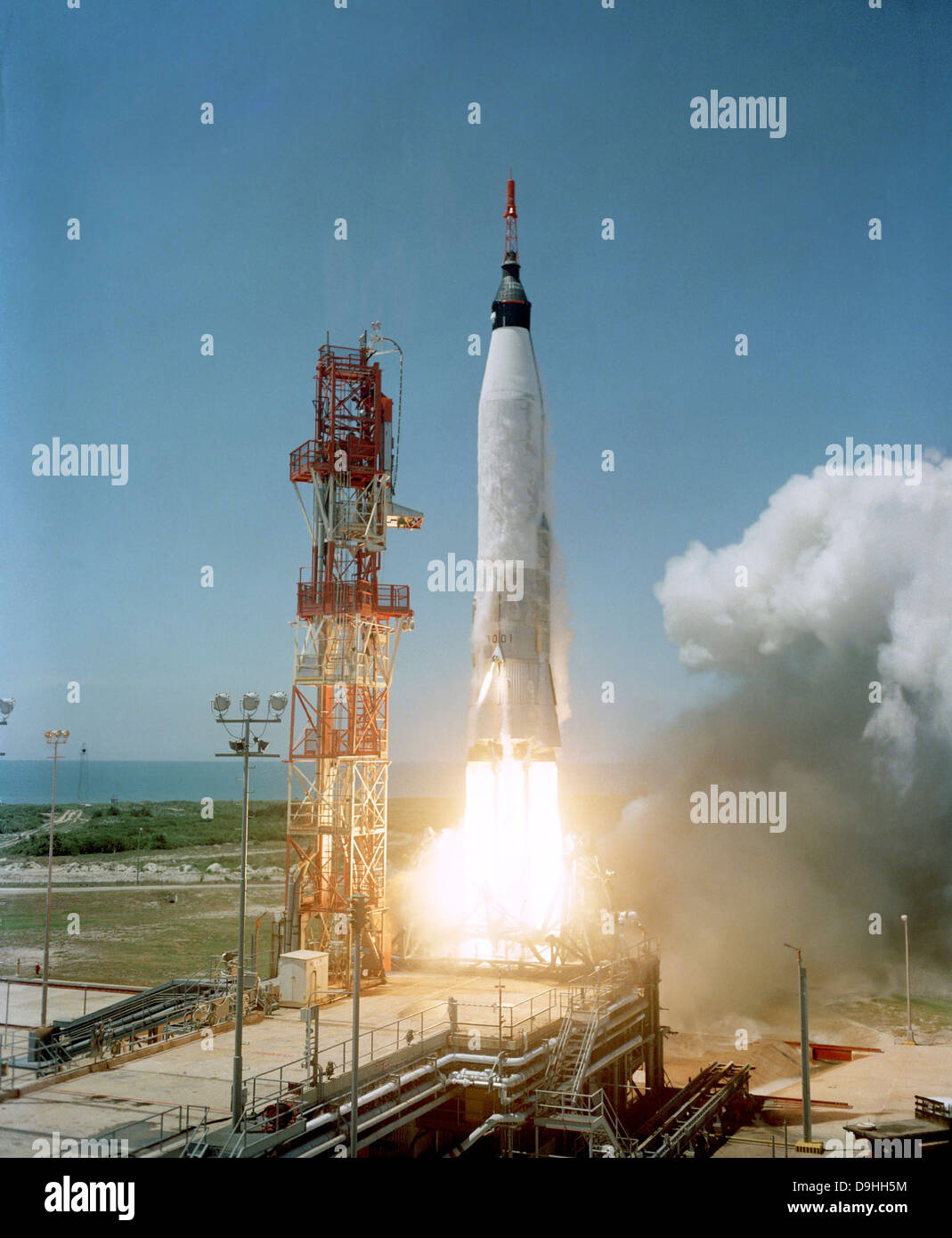 April 25, 1961 - View of the Mercury-Atlas 3 liftoff from Cape Canaveral, Florida. Stock Photohttps://www.alamy.com/image-license-details/?v=1https://www.alamy.com/stock-photo-april-25-1961-view-of-the-mercury-atlas-3-liftoff-from-cape-canaveral-57549680.html
April 25, 1961 - View of the Mercury-Atlas 3 liftoff from Cape Canaveral, Florida. Stock Photohttps://www.alamy.com/image-license-details/?v=1https://www.alamy.com/stock-photo-april-25-1961-view-of-the-mercury-atlas-3-liftoff-from-cape-canaveral-57549680.htmlRFD9HH5M–April 25, 1961 - View of the Mercury-Atlas 3 liftoff from Cape Canaveral, Florida.
 (July 29, 1960) The main objectives of Mercury Atlas-1's (MA-1) were to recover the capsule and test the integrity of the Mercury capsule structure and afterbody shingles. About one minute after liftoff MA-1 exploded and the remaining debris landed 7 miles off the Florida shore. The debris was collected and engineers attempted to reassemble MA-1 to determine the cause of the explosion. Image # : S-67-19582 Stock Photohttps://www.alamy.com/image-license-details/?v=1https://www.alamy.com/stock-photo-july-29-1960-the-main-objectives-of-mercury-atlas-1s-ma-1-were-to-111968284.html
(July 29, 1960) The main objectives of Mercury Atlas-1's (MA-1) were to recover the capsule and test the integrity of the Mercury capsule structure and afterbody shingles. About one minute after liftoff MA-1 exploded and the remaining debris landed 7 miles off the Florida shore. The debris was collected and engineers attempted to reassemble MA-1 to determine the cause of the explosion. Image # : S-67-19582 Stock Photohttps://www.alamy.com/image-license-details/?v=1https://www.alamy.com/stock-photo-july-29-1960-the-main-objectives-of-mercury-atlas-1s-ma-1-were-to-111968284.htmlRMGE4GK8–(July 29, 1960) The main objectives of Mercury Atlas-1's (MA-1) were to recover the capsule and test the integrity of the Mercury capsule structure and afterbody shingles. About one minute after liftoff MA-1 exploded and the remaining debris landed 7 miles off the Florida shore. The debris was collected and engineers attempted to reassemble MA-1 to determine the cause of the explosion. Image # : S-67-19582
 The Mercury 3 rockets launches on an Atlas rocket on 25 April 1961 Stock Photohttps://www.alamy.com/image-license-details/?v=1https://www.alamy.com/the-mercury-3-rockets-launches-on-an-atlas-rocket-on-25-april-1961-image438492021.html
The Mercury 3 rockets launches on an Atlas rocket on 25 April 1961 Stock Photohttps://www.alamy.com/image-license-details/?v=1https://www.alamy.com/the-mercury-3-rockets-launches-on-an-atlas-rocket-on-25-april-1961-image438492021.htmlRM2GDB119–The Mercury 3 rockets launches on an Atlas rocket on 25 April 1961
 View of the launch of Mercury-Atlas 4 (MA-4) spacecraft from Cape Canaveral, Florida. September 13, 1961 Stock Photohttps://www.alamy.com/image-license-details/?v=1https://www.alamy.com/view-of-the-launch-of-mercury-atlas-4-ma-4-spacecraft-from-cape-canaveral-florida-september-13-1961-image214138867.html
View of the launch of Mercury-Atlas 4 (MA-4) spacecraft from Cape Canaveral, Florida. September 13, 1961 Stock Photohttps://www.alamy.com/image-license-details/?v=1https://www.alamy.com/view-of-the-launch-of-mercury-atlas-4-ma-4-spacecraft-from-cape-canaveral-florida-september-13-1961-image214138867.htmlRMPCAT8K–View of the launch of Mercury-Atlas 4 (MA-4) spacecraft from Cape Canaveral, Florida. September 13, 1961
 113D; Mercury Manned (Schirra); liftoff; ETR 14 -Atlas launch--'Mercury binder; 113D; 10-3-62; cx14 (launch complex 14?) Stock Photohttps://www.alamy.com/image-license-details/?v=1https://www.alamy.com/stock-photo-113d-mercury-manned-schirra-liftoff-etr-14-atlas-launch-mercury-binder-85150005.html
113D; Mercury Manned (Schirra); liftoff; ETR 14 -Atlas launch--'Mercury binder; 113D; 10-3-62; cx14 (launch complex 14?) Stock Photohttps://www.alamy.com/image-license-details/?v=1https://www.alamy.com/stock-photo-113d-mercury-manned-schirra-liftoff-etr-14-atlas-launch-mercury-binder-85150005.htmlRMEXEWKH–113D; Mercury Manned (Schirra); liftoff; ETR 14 -Atlas launch--'Mercury binder; 113D; 10-3-62; cx14 (launch complex 14?)
 View of the liftoff of Mercury-Atlas 5 from Kennedy Space Center, Florida. Stock Photohttps://www.alamy.com/image-license-details/?v=1https://www.alamy.com/stock-photo-view-of-the-liftoff-of-mercury-atlas-5-from-kennedy-space-center-florida-57548740.html
View of the liftoff of Mercury-Atlas 5 from Kennedy Space Center, Florida. Stock Photohttps://www.alamy.com/image-license-details/?v=1https://www.alamy.com/stock-photo-view-of-the-liftoff-of-mercury-atlas-5-from-kennedy-space-center-florida-57548740.htmlRFD9HG04–View of the liftoff of Mercury-Atlas 5 from Kennedy Space Center, Florida.
 Mercury-Atlas 2 liftoff Stock Photohttps://www.alamy.com/image-license-details/?v=1https://www.alamy.com/stock-image-mercury-atlas-2-liftoff-169339339.html
Mercury-Atlas 2 liftoff Stock Photohttps://www.alamy.com/image-license-details/?v=1https://www.alamy.com/stock-image-mercury-atlas-2-liftoff-169339339.htmlRMKRE21F–Mercury-Atlas 2 liftoff
 Scott Carpenter's Aurora 7 Mercury Atlas rocket lifts off from Pad 14, Cape Canaveral, Florida, on May 24, 1962. Stock Photohttps://www.alamy.com/image-license-details/?v=1https://www.alamy.com/scott-carpenters-aurora-7-mercury-atlas-rocket-lifts-off-from-pad-14-cape-canaveral-florida-on-may-24-1962-image211647282.html
Scott Carpenter's Aurora 7 Mercury Atlas rocket lifts off from Pad 14, Cape Canaveral, Florida, on May 24, 1962. Stock Photohttps://www.alamy.com/image-license-details/?v=1https://www.alamy.com/scott-carpenters-aurora-7-mercury-atlas-rocket-lifts-off-from-pad-14-cape-canaveral-florida-on-may-24-1962-image211647282.htmlRMP89A7E–Scott Carpenter's Aurora 7 Mercury Atlas rocket lifts off from Pad 14, Cape Canaveral, Florida, on May 24, 1962.
 Mercury-Atlas 9 lifts off from its launch pad at Cape Canaveral, Florida. Stock Photohttps://www.alamy.com/image-license-details/?v=1https://www.alamy.com/stock-photo-mercury-atlas-9-lifts-off-from-its-launch-pad-at-cape-canaveral-florida-57548663.html
Mercury-Atlas 9 lifts off from its launch pad at Cape Canaveral, Florida. Stock Photohttps://www.alamy.com/image-license-details/?v=1https://www.alamy.com/stock-photo-mercury-atlas-9-lifts-off-from-its-launch-pad-at-cape-canaveral-florida-57548663.htmlRFD9HFWB–Mercury-Atlas 9 lifts off from its launch pad at Cape Canaveral, Florida.
 (20 Feb. 1962) --- During the early hours of dawn, newsmen, photographers and T.V. reporters await the Mercury-Atlas 6 (MA-6) liftoff at Cape Canaveral, Florida. Stock Photohttps://www.alamy.com/image-license-details/?v=1https://www.alamy.com/20-feb-1962-during-the-early-hours-of-dawn-newsmen-photographers-and-tv-reporters-await-the-mercury-atlas-6-ma-6-liftoff-at-cape-canaveral-florida-image223583196.html
(20 Feb. 1962) --- During the early hours of dawn, newsmen, photographers and T.V. reporters await the Mercury-Atlas 6 (MA-6) liftoff at Cape Canaveral, Florida. Stock Photohttps://www.alamy.com/image-license-details/?v=1https://www.alamy.com/20-feb-1962-during-the-early-hours-of-dawn-newsmen-photographers-and-tv-reporters-await-the-mercury-atlas-6-ma-6-liftoff-at-cape-canaveral-florida-image223583196.htmlRMPYN2J4–(20 Feb. 1962) --- During the early hours of dawn, newsmen, photographers and T.V. reporters await the Mercury-Atlas 6 (MA-6) liftoff at Cape Canaveral, Florida.
 September 13, 1961 - View of the launch of the Mercury-Atlas 4 spacecraft from Cape Canaveral, Florida. Stock Photohttps://www.alamy.com/image-license-details/?v=1https://www.alamy.com/stock-photo-september-13-1961-view-of-the-launch-of-the-mercury-atlas-4-spacecraft-57548737.html
September 13, 1961 - View of the launch of the Mercury-Atlas 4 spacecraft from Cape Canaveral, Florida. Stock Photohttps://www.alamy.com/image-license-details/?v=1https://www.alamy.com/stock-photo-september-13-1961-view-of-the-launch-of-the-mercury-atlas-4-spacecraft-57548737.htmlRFD9HG01–September 13, 1961 - View of the launch of the Mercury-Atlas 4 spacecraft from Cape Canaveral, Florida.
 Scott Carpenter's Aurora 7 Mercury Atlas rocket lifts off from Pad 14, Cape Canaveral, Florida, on May 24, 1962. Stock Photohttps://www.alamy.com/image-license-details/?v=1https://www.alamy.com/scott-carpenters-aurora-7-mercury-atlas-rocket-lifts-off-from-pad-14-cape-canaveral-florida-on-may-24-1962-image375776835.html
Scott Carpenter's Aurora 7 Mercury Atlas rocket lifts off from Pad 14, Cape Canaveral, Florida, on May 24, 1962. Stock Photohttps://www.alamy.com/image-license-details/?v=1https://www.alamy.com/scott-carpenters-aurora-7-mercury-atlas-rocket-lifts-off-from-pad-14-cape-canaveral-florida-on-may-24-1962-image375776835.htmlRM2CRA357–Scott Carpenter's Aurora 7 Mercury Atlas rocket lifts off from Pad 14, Cape Canaveral, Florida, on May 24, 1962.
 (29 Nov. 1961) --- View of the liftoff of Mercury-Atlas 5 (MA-5) carrying space chimpanzee 'Enos' on Nov. 29, 1961 from Kennedy Space Center, Florida Stock Photohttps://www.alamy.com/image-license-details/?v=1https://www.alamy.com/29-nov-1961-view-of-the-liftoff-of-mercury-atlas-5-ma-5-carrying-space-chimpanzee-enos-on-nov-29-1961-from-kennedy-space-center-florida-image447242960.html
(29 Nov. 1961) --- View of the liftoff of Mercury-Atlas 5 (MA-5) carrying space chimpanzee 'Enos' on Nov. 29, 1961 from Kennedy Space Center, Florida Stock Photohttps://www.alamy.com/image-license-details/?v=1https://www.alamy.com/29-nov-1961-view-of-the-liftoff-of-mercury-atlas-5-ma-5-carrying-space-chimpanzee-enos-on-nov-29-1961-from-kennedy-space-center-florida-image447242960.htmlRM2GYHJXT–(29 Nov. 1961) --- View of the liftoff of Mercury-Atlas 5 (MA-5) carrying space chimpanzee 'Enos' on Nov. 29, 1961 from Kennedy Space Center, Florida
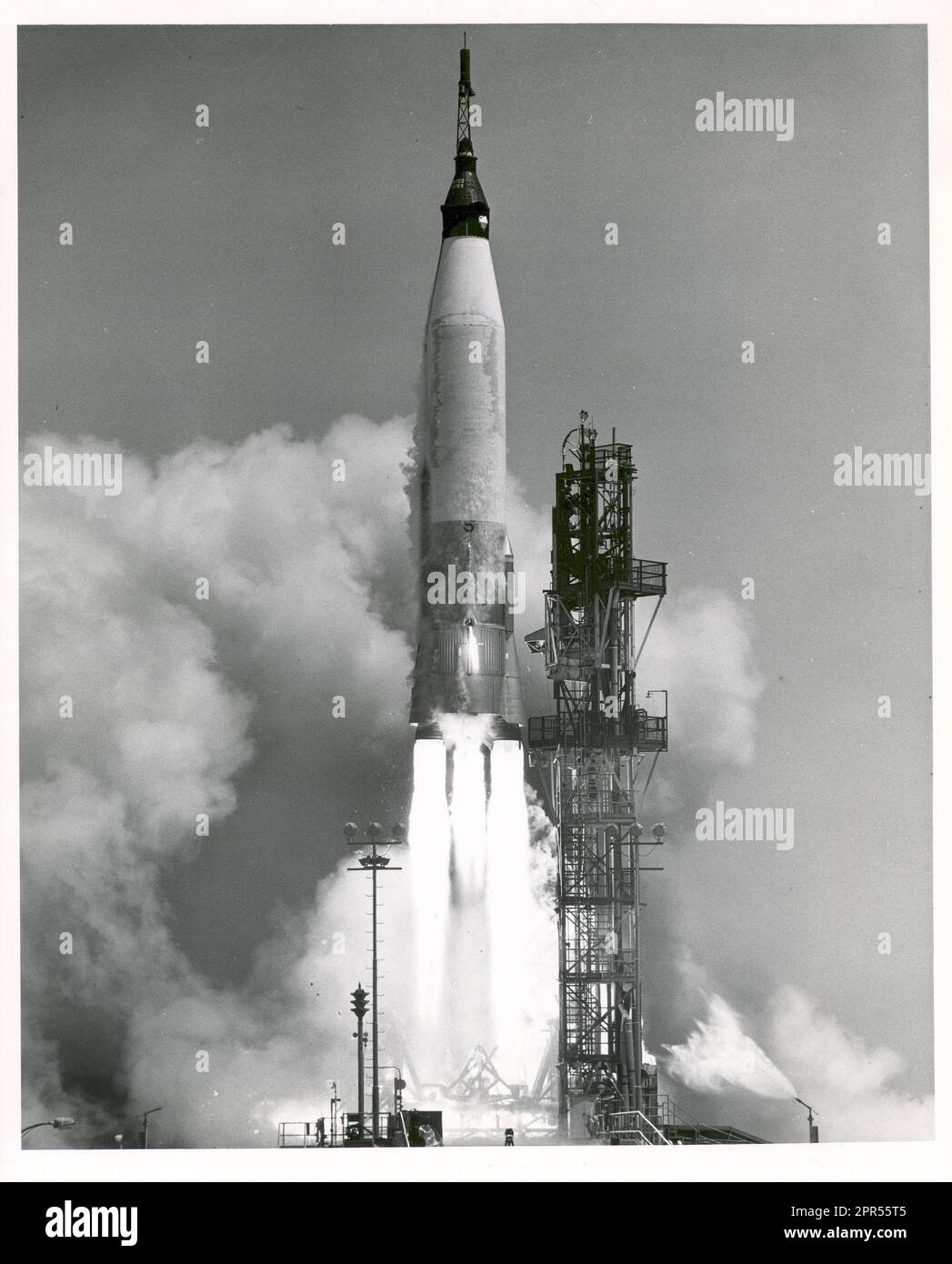 A NASA Project Mercury spacecraft was test launched at 11:15 AM EST on April 25, 1961 from Cape Canaveral, Florida, in a test designed to qualify the Mercury Spacecraft and all systems, which must function during orbit and reentry from orbit. The Mercury-Atlas vehicle was destroyed by Range Safety Officer about 40 seconds after liftoff. The spacecraft was recovered and appeared to be in good condition. Atlas was designed to launch payloads into low Earth orbit, geosynchronous transfer orbit or geosynchronous orbit. NASA first launched Atlas as a space launch vehicle in 1958. Project SCORE, the Stock Photohttps://www.alamy.com/image-license-details/?v=1https://www.alamy.com/a-nasa-project-mercury-spacecraft-was-test-launched-at-1115-am-est-on-april-25-1961-from-cape-canaveral-florida-in-a-test-designed-to-qualify-the-mercury-spacecraft-and-all-systems-which-must-function-during-orbit-and-reentry-from-orbit-the-mercury-atlas-vehicle-was-destroyed-by-range-safety-officer-about-40-seconds-after-liftoff-the-spacecraft-was-recovered-and-appeared-to-be-in-good-condition-atlas-was-designed-to-launch-payloads-into-low-earth-orbit-geosynchronous-transfer-orbit-or-geosynchronous-orbit-nasa-first-launched-atlas-as-a-space-launch-vehicle-in-1958-project-score-the-image547772853.html
A NASA Project Mercury spacecraft was test launched at 11:15 AM EST on April 25, 1961 from Cape Canaveral, Florida, in a test designed to qualify the Mercury Spacecraft and all systems, which must function during orbit and reentry from orbit. The Mercury-Atlas vehicle was destroyed by Range Safety Officer about 40 seconds after liftoff. The spacecraft was recovered and appeared to be in good condition. Atlas was designed to launch payloads into low Earth orbit, geosynchronous transfer orbit or geosynchronous orbit. NASA first launched Atlas as a space launch vehicle in 1958. Project SCORE, the Stock Photohttps://www.alamy.com/image-license-details/?v=1https://www.alamy.com/a-nasa-project-mercury-spacecraft-was-test-launched-at-1115-am-est-on-april-25-1961-from-cape-canaveral-florida-in-a-test-designed-to-qualify-the-mercury-spacecraft-and-all-systems-which-must-function-during-orbit-and-reentry-from-orbit-the-mercury-atlas-vehicle-was-destroyed-by-range-safety-officer-about-40-seconds-after-liftoff-the-spacecraft-was-recovered-and-appeared-to-be-in-good-condition-atlas-was-designed-to-launch-payloads-into-low-earth-orbit-geosynchronous-transfer-orbit-or-geosynchronous-orbit-nasa-first-launched-atlas-as-a-space-launch-vehicle-in-1958-project-score-the-image547772853.htmlRM2PR55T5–A NASA Project Mercury spacecraft was test launched at 11:15 AM EST on April 25, 1961 from Cape Canaveral, Florida, in a test designed to qualify the Mercury Spacecraft and all systems, which must function during orbit and reentry from orbit. The Mercury-Atlas vehicle was destroyed by Range Safety Officer about 40 seconds after liftoff. The spacecraft was recovered and appeared to be in good condition. Atlas was designed to launch payloads into low Earth orbit, geosynchronous transfer orbit or geosynchronous orbit. NASA first launched Atlas as a space launch vehicle in 1958. Project SCORE, the
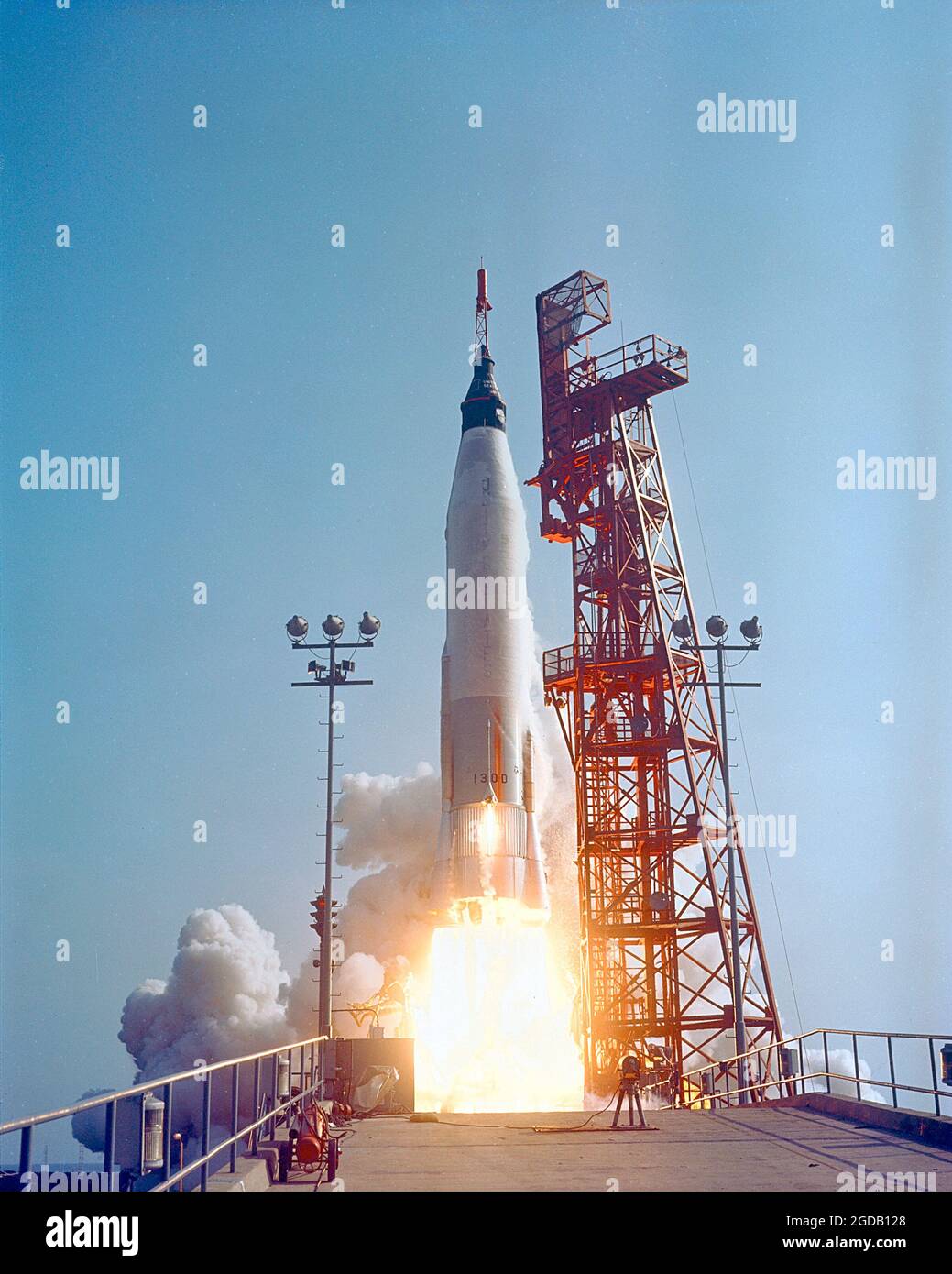 Mercury-Atlas 9 lifts off from Cape Canaveral on 15 May 1963 with astronaut L. Gordon Cooper aboard Faith 7. Stock Photohttps://www.alamy.com/image-license-details/?v=1https://www.alamy.com/mercury-atlas-9-lifts-off-from-cape-canaveral-on-15-may-1963-with-astronaut-l-gordon-cooper-aboard-faith-7-image438492048.html
Mercury-Atlas 9 lifts off from Cape Canaveral on 15 May 1963 with astronaut L. Gordon Cooper aboard Faith 7. Stock Photohttps://www.alamy.com/image-license-details/?v=1https://www.alamy.com/mercury-atlas-9-lifts-off-from-cape-canaveral-on-15-may-1963-with-astronaut-l-gordon-cooper-aboard-faith-7-image438492048.htmlRM2GDB128–Mercury-Atlas 9 lifts off from Cape Canaveral on 15 May 1963 with astronaut L. Gordon Cooper aboard Faith 7.
 February 24, 1961 - The launch of the Mercury Atlas (MA-2), an unmanned suborbital Mercury capsule test. Stock Photohttps://www.alamy.com/image-license-details/?v=1https://www.alamy.com/stock-photo-february-24-1961-the-launch-of-the-mercury-atlas-ma-2-an-unmanned-57548455.html
February 24, 1961 - The launch of the Mercury Atlas (MA-2), an unmanned suborbital Mercury capsule test. Stock Photohttps://www.alamy.com/image-license-details/?v=1https://www.alamy.com/stock-photo-february-24-1961-the-launch-of-the-mercury-atlas-ma-2-an-unmanned-57548455.htmlRFD9HFHY–February 24, 1961 - The launch of the Mercury Atlas (MA-2), an unmanned suborbital Mercury capsule test.
 Sigma 7 Mercury-Atlas Launch, 1962 Stock Photohttps://www.alamy.com/image-license-details/?v=1https://www.alamy.com/stock-photo-sigma-7-mercury-atlas-launch-1962-135097003.html
Sigma 7 Mercury-Atlas Launch, 1962 Stock Photohttps://www.alamy.com/image-license-details/?v=1https://www.alamy.com/stock-photo-sigma-7-mercury-atlas-launch-1962-135097003.htmlRMHRP5GY–Sigma 7 Mercury-Atlas Launch, 1962
 The main objectives of Mercury Atlas-1's (MA-1) were to recover the capsule and test the integrity of the Mercury capsule structure and afterbody shingles. About one minute after liftoff MA-1 exploded and the remaining debris landed 7 miles off the Florida shore. The debris was collected and engineers attempted to reassemble MA-1 to determine the cause of the explosion. Stock Photohttps://www.alamy.com/image-license-details/?v=1https://www.alamy.com/the-main-objectives-of-mercury-atlas-1s-ma-1-were-to-recover-the-capsule-and-test-the-integrity-of-the-mercury-capsule-structure-and-afterbody-shingles-about-one-minute-after-liftoff-ma-1-exploded-and-the-remaining-debris-landed-7-miles-off-the-florida-shore-the-debris-was-collected-and-engineers-attempted-to-reassemble-ma-1-to-determine-the-cause-of-the-explosion-image547772821.html
The main objectives of Mercury Atlas-1's (MA-1) were to recover the capsule and test the integrity of the Mercury capsule structure and afterbody shingles. About one minute after liftoff MA-1 exploded and the remaining debris landed 7 miles off the Florida shore. The debris was collected and engineers attempted to reassemble MA-1 to determine the cause of the explosion. Stock Photohttps://www.alamy.com/image-license-details/?v=1https://www.alamy.com/the-main-objectives-of-mercury-atlas-1s-ma-1-were-to-recover-the-capsule-and-test-the-integrity-of-the-mercury-capsule-structure-and-afterbody-shingles-about-one-minute-after-liftoff-ma-1-exploded-and-the-remaining-debris-landed-7-miles-off-the-florida-shore-the-debris-was-collected-and-engineers-attempted-to-reassemble-ma-1-to-determine-the-cause-of-the-explosion-image547772821.htmlRM2PR55R1–The main objectives of Mercury Atlas-1's (MA-1) were to recover the capsule and test the integrity of the Mercury capsule structure and afterbody shingles. About one minute after liftoff MA-1 exploded and the remaining debris landed 7 miles off the Florida shore. The debris was collected and engineers attempted to reassemble MA-1 to determine the cause of the explosion.
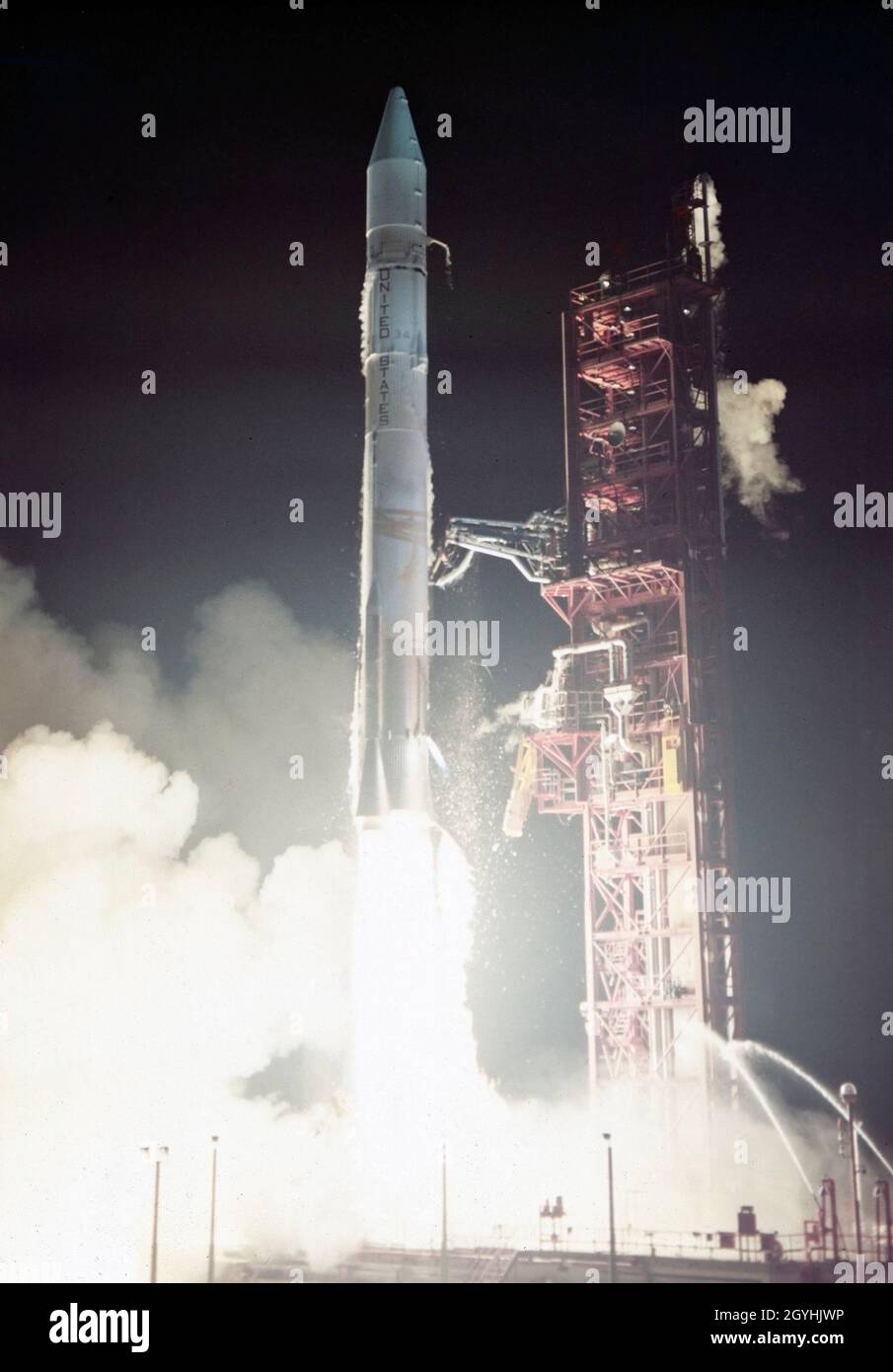 LAUNCH OF MARINER 10, LAUNCH VEHICLE-ATLAS-CENTAUR. LAUNCH DATE-NOVEMBER 3, 1973 PLANETARY EXPLORATION (VENUS AND MERCURY) Stock Photohttps://www.alamy.com/image-license-details/?v=1https://www.alamy.com/launch-of-mariner-10-launch-vehicle-atlas-centaur-launch-date-november-3-1973-planetary-exploration-venus-and-mercury-image447242930.html
LAUNCH OF MARINER 10, LAUNCH VEHICLE-ATLAS-CENTAUR. LAUNCH DATE-NOVEMBER 3, 1973 PLANETARY EXPLORATION (VENUS AND MERCURY) Stock Photohttps://www.alamy.com/image-license-details/?v=1https://www.alamy.com/launch-of-mariner-10-launch-vehicle-atlas-centaur-launch-date-november-3-1973-planetary-exploration-venus-and-mercury-image447242930.htmlRM2GYHJWP–LAUNCH OF MARINER 10, LAUNCH VEHICLE-ATLAS-CENTAUR. LAUNCH DATE-NOVEMBER 3, 1973 PLANETARY EXPLORATION (VENUS AND MERCURY)
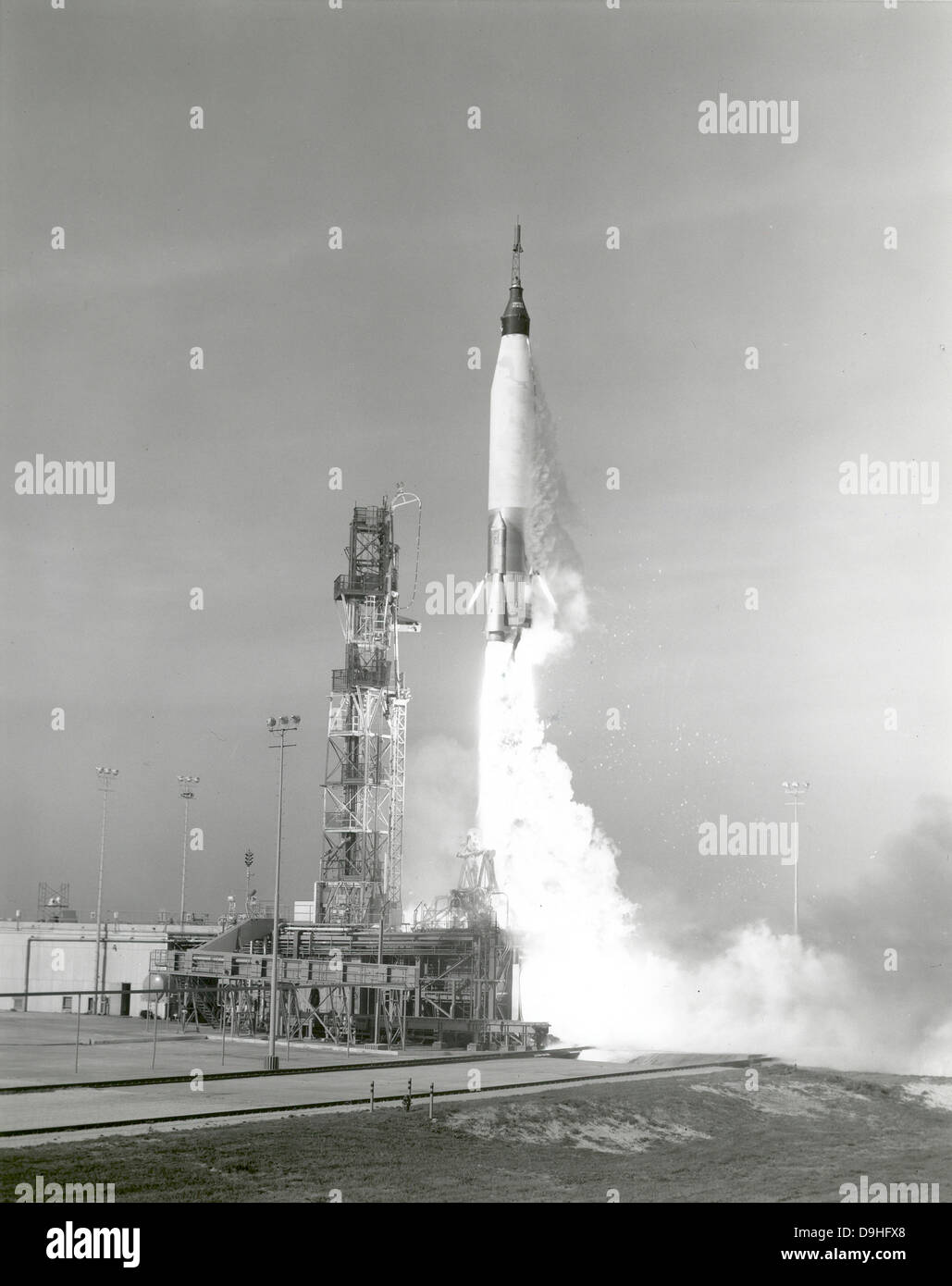 A NASA Project Mercury spacecraft is test launched from Cape Canaveral, Florida Stock Photohttps://www.alamy.com/image-license-details/?v=1https://www.alamy.com/stock-photo-a-nasa-project-mercury-spacecraft-is-test-launched-from-cape-canaveral-57548688.html
A NASA Project Mercury spacecraft is test launched from Cape Canaveral, Florida Stock Photohttps://www.alamy.com/image-license-details/?v=1https://www.alamy.com/stock-photo-a-nasa-project-mercury-spacecraft-is-test-launched-from-cape-canaveral-57548688.htmlRFD9HFX8–A NASA Project Mercury spacecraft is test launched from Cape Canaveral, Florida
 (3 Oct. 1962) --- Launch of the Mercury-Atlas 8 (MA-8) 'Sigma 7' mission, carrying astronaut Walter M. Schirra Jr., pilot of the Earth-orbital spaceflight. Stock Photohttps://www.alamy.com/image-license-details/?v=1https://www.alamy.com/3-oct-1962-launch-of-the-mercury-atlas-8-ma-8-sigma-7-mission-carrying-astronaut-walter-m-schirra-jr-pilot-of-the-earth-orbital-spaceflight-image448053403.html
(3 Oct. 1962) --- Launch of the Mercury-Atlas 8 (MA-8) 'Sigma 7' mission, carrying astronaut Walter M. Schirra Jr., pilot of the Earth-orbital spaceflight. Stock Photohttps://www.alamy.com/image-license-details/?v=1https://www.alamy.com/3-oct-1962-launch-of-the-mercury-atlas-8-ma-8-sigma-7-mission-carrying-astronaut-walter-m-schirra-jr-pilot-of-the-earth-orbital-spaceflight-image448053403.htmlRM2H0XGK7–(3 Oct. 1962) --- Launch of the Mercury-Atlas 8 (MA-8) 'Sigma 7' mission, carrying astronaut Walter M. Schirra Jr., pilot of the Earth-orbital spaceflight.
 Liftoff of Mercury Atlas 6, John Glenn’s orbital flight, from Cape Canaveral, Fla., on Feb. 20, 1962, at 9:47 a.m. Glenn’s three orbits covered more than 75,000 miles. (U.S. Air Force photo) Stock Photohttps://www.alamy.com/image-license-details/?v=1https://www.alamy.com/stock-photo-liftoff-of-mercury-atlas-6-john-glenns-orbital-flight-from-cape-canaveral-129329465.html
Liftoff of Mercury Atlas 6, John Glenn’s orbital flight, from Cape Canaveral, Fla., on Feb. 20, 1962, at 9:47 a.m. Glenn’s three orbits covered more than 75,000 miles. (U.S. Air Force photo) Stock Photohttps://www.alamy.com/image-license-details/?v=1https://www.alamy.com/stock-photo-liftoff-of-mercury-atlas-6-john-glenns-orbital-flight-from-cape-canaveral-129329465.htmlRMHEBD1D–Liftoff of Mercury Atlas 6, John Glenn’s orbital flight, from Cape Canaveral, Fla., on Feb. 20, 1962, at 9:47 a.m. Glenn’s three orbits covered more than 75,000 miles. (U.S. Air Force photo)
 (29 July 1960) --- Launch of the unmanned Mercury-Atlas 1 (MA-1) from Cape Canaveral, Florida. Premature engine cutoff at launch terminated the test. Emergency escape system jettisoned. The Atlas exploded 65 seconds after launch. Stock Photohttps://www.alamy.com/image-license-details/?v=1https://www.alamy.com/29-july-1960-launch-of-the-unmanned-mercury-atlas-1-ma-1-from-cape-canaveral-florida-premature-engine-cutoff-at-launch-terminated-the-test-emergency-escape-system-jettisoned-the-atlas-exploded-65-seconds-after-launch-image448053406.html
(29 July 1960) --- Launch of the unmanned Mercury-Atlas 1 (MA-1) from Cape Canaveral, Florida. Premature engine cutoff at launch terminated the test. Emergency escape system jettisoned. The Atlas exploded 65 seconds after launch. Stock Photohttps://www.alamy.com/image-license-details/?v=1https://www.alamy.com/29-july-1960-launch-of-the-unmanned-mercury-atlas-1-ma-1-from-cape-canaveral-florida-premature-engine-cutoff-at-launch-terminated-the-test-emergency-escape-system-jettisoned-the-atlas-exploded-65-seconds-after-launch-image448053406.htmlRM2H0XGKA–(29 July 1960) --- Launch of the unmanned Mercury-Atlas 1 (MA-1) from Cape Canaveral, Florida. Premature engine cutoff at launch terminated the test. Emergency escape system jettisoned. The Atlas exploded 65 seconds after launch.
 Mercury-Atlas launch--'Mercury binder; 113D; liftoff; 10362 15473164164 o Mercury-Atlas launch--'Mercury binder; 113D; liftoff; 10/3/62 Stock Photohttps://www.alamy.com/image-license-details/?v=1https://www.alamy.com/stock-photo-mercury-atlas-launch-mercury-binder-113d-liftoff-10362-15473164164-77338940.html
Mercury-Atlas launch--'Mercury binder; 113D; liftoff; 10362 15473164164 o Mercury-Atlas launch--'Mercury binder; 113D; liftoff; 10/3/62 Stock Photohttps://www.alamy.com/image-license-details/?v=1https://www.alamy.com/stock-photo-mercury-atlas-launch-mercury-binder-113d-liftoff-10362-15473164164-77338940.htmlRMEDR2H0–Mercury-Atlas launch--'Mercury binder; 113D; liftoff; 10362 15473164164 o Mercury-Atlas launch--'Mercury binder; 113D; liftoff; 10/3/62
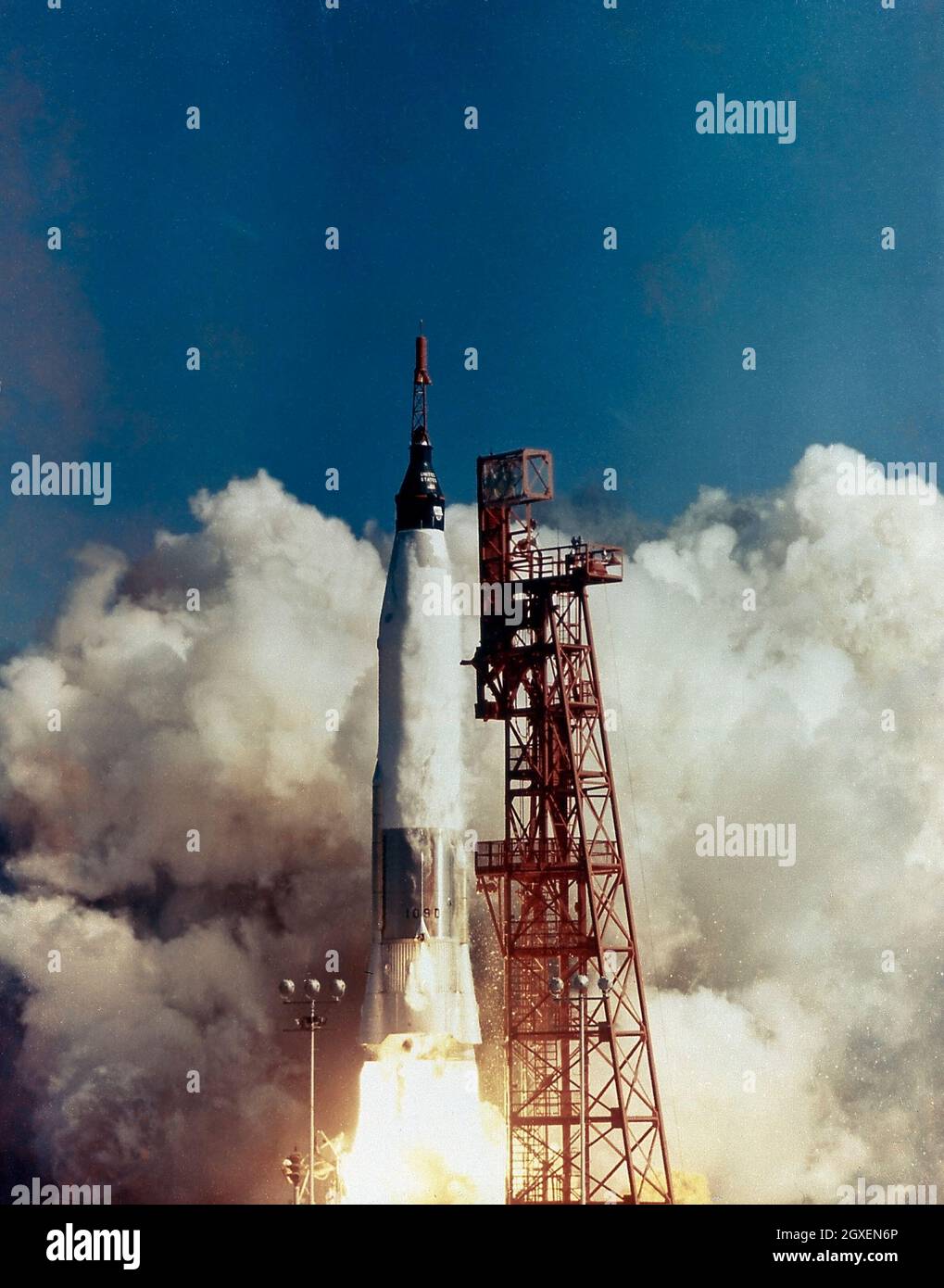 The launch of the MA-6, Friendship 7, on February 20, 1962. Boosted by the Mercury-Atlas vehicle, a modified Atlas Intercontinental Ballistic Missile (ICBM), Friendship 7 was the first U.S. manned orbital flight and carried Astronaut John H. Glenn into orbit. Astronaut Glenn became the first American to orbit the Earth. Stock Photohttps://www.alamy.com/image-license-details/?v=1https://www.alamy.com/the-launch-of-the-ma-6-friendship-7-on-february-20-1962-boosted-by-the-mercury-atlas-vehicle-a-modified-atlas-intercontinental-ballistic-missile-icbm-friendship-7-was-the-first-us-manned-orbital-flight-and-carried-astronaut-john-h-glenn-into-orbit-astronaut-glenn-became-the-first-american-to-orbit-the-earth-image446564238.html
The launch of the MA-6, Friendship 7, on February 20, 1962. Boosted by the Mercury-Atlas vehicle, a modified Atlas Intercontinental Ballistic Missile (ICBM), Friendship 7 was the first U.S. manned orbital flight and carried Astronaut John H. Glenn into orbit. Astronaut Glenn became the first American to orbit the Earth. Stock Photohttps://www.alamy.com/image-license-details/?v=1https://www.alamy.com/the-launch-of-the-ma-6-friendship-7-on-february-20-1962-boosted-by-the-mercury-atlas-vehicle-a-modified-atlas-intercontinental-ballistic-missile-icbm-friendship-7-was-the-first-us-manned-orbital-flight-and-carried-astronaut-john-h-glenn-into-orbit-astronaut-glenn-became-the-first-american-to-orbit-the-earth-image446564238.htmlRM2GXEN6P–The launch of the MA-6, Friendship 7, on February 20, 1962. Boosted by the Mercury-Atlas vehicle, a modified Atlas Intercontinental Ballistic Missile (ICBM), Friendship 7 was the first U.S. manned orbital flight and carried Astronaut John H. Glenn into orbit. Astronaut Glenn became the first American to orbit the Earth.
 Mercury-Atlas 1 liftoff Stock Photohttps://www.alamy.com/image-license-details/?v=1https://www.alamy.com/stock-image-mercury-atlas-1-liftoff-169339310.html
Mercury-Atlas 1 liftoff Stock Photohttps://www.alamy.com/image-license-details/?v=1https://www.alamy.com/stock-image-mercury-atlas-1-liftoff-169339310.htmlRMKRE20E–Mercury-Atlas 1 liftoff
 Launched atop an Atlas booster, the Agena target vehicle (ATV) was a spacecraft used by NASA to develop and practice orbital space rendezvous and docking techniques in preparation for the Apollo program lunar missions. This particular launch preceded the Gemini 12, which launched aboard a Titan launch vehicle one and one half hours later. The objective was for Agena and Gemini to rendezvous in space and practice docking procedures. An intermediate step between Project Mercury and the Apollo Program, the Gemini Program's major objectives were to subject two men and supporting equipment to long Stock Photohttps://www.alamy.com/image-license-details/?v=1https://www.alamy.com/launched-atop-an-atlas-booster-the-agena-target-vehicle-atv-was-a-spacecraft-used-by-nasa-to-develop-and-practice-orbital-space-rendezvous-and-docking-techniques-in-preparation-for-the-apollo-program-lunar-missions-this-particular-launch-preceded-the-gemini-12-which-launched-aboard-a-titan-launch-vehicle-one-and-one-half-hours-later-the-objective-was-for-agena-and-gemini-to-rendezvous-in-space-and-practice-docking-procedures-an-intermediate-step-between-project-mercury-and-the-apollo-program-the-gemini-programs-major-objectives-were-to-subject-two-men-and-supporting-equipment-to-long-image442385763.html
Launched atop an Atlas booster, the Agena target vehicle (ATV) was a spacecraft used by NASA to develop and practice orbital space rendezvous and docking techniques in preparation for the Apollo program lunar missions. This particular launch preceded the Gemini 12, which launched aboard a Titan launch vehicle one and one half hours later. The objective was for Agena and Gemini to rendezvous in space and practice docking procedures. An intermediate step between Project Mercury and the Apollo Program, the Gemini Program's major objectives were to subject two men and supporting equipment to long Stock Photohttps://www.alamy.com/image-license-details/?v=1https://www.alamy.com/launched-atop-an-atlas-booster-the-agena-target-vehicle-atv-was-a-spacecraft-used-by-nasa-to-develop-and-practice-orbital-space-rendezvous-and-docking-techniques-in-preparation-for-the-apollo-program-lunar-missions-this-particular-launch-preceded-the-gemini-12-which-launched-aboard-a-titan-launch-vehicle-one-and-one-half-hours-later-the-objective-was-for-agena-and-gemini-to-rendezvous-in-space-and-practice-docking-procedures-an-intermediate-step-between-project-mercury-and-the-apollo-program-the-gemini-programs-major-objectives-were-to-subject-two-men-and-supporting-equipment-to-long-image442385763.htmlRM2GKMBFF–Launched atop an Atlas booster, the Agena target vehicle (ATV) was a spacecraft used by NASA to develop and practice orbital space rendezvous and docking techniques in preparation for the Apollo program lunar missions. This particular launch preceded the Gemini 12, which launched aboard a Titan launch vehicle one and one half hours later. The objective was for Agena and Gemini to rendezvous in space and practice docking procedures. An intermediate step between Project Mercury and the Apollo Program, the Gemini Program's major objectives were to subject two men and supporting equipment to long
 STS-95 Payload Specialist John H. Glenn Jr. (right), senator from Ohio, embraces his son, David, after landing at Kennedy Space Center's Shuttle Landing Facility at Cape Canaveral, Florida aboard a T-38 jet on October 26, 1998. Barely visible behind them is Glenn's daughter, Lyn. Glenn and other crewmembers flew into KSC to make final preparations for launch. Targeted for liftoff at 2 p.m. on Oct. 29, the STS-95 mission includes research payloads such as the Spartan solar-observing deployable spacecraft, the Hubble Space Telescope Orbital Systems Test Platform, the International Extreme Ultrav Stock Photohttps://www.alamy.com/image-license-details/?v=1https://www.alamy.com/stock-photo-sts-95-payload-specialist-john-h-glenn-jr-right-senator-from-ohio-128237864.html
STS-95 Payload Specialist John H. Glenn Jr. (right), senator from Ohio, embraces his son, David, after landing at Kennedy Space Center's Shuttle Landing Facility at Cape Canaveral, Florida aboard a T-38 jet on October 26, 1998. Barely visible behind them is Glenn's daughter, Lyn. Glenn and other crewmembers flew into KSC to make final preparations for launch. Targeted for liftoff at 2 p.m. on Oct. 29, the STS-95 mission includes research payloads such as the Spartan solar-observing deployable spacecraft, the Hubble Space Telescope Orbital Systems Test Platform, the International Extreme Ultrav Stock Photohttps://www.alamy.com/image-license-details/?v=1https://www.alamy.com/stock-photo-sts-95-payload-specialist-john-h-glenn-jr-right-senator-from-ohio-128237864.htmlRMHCHMKM–STS-95 Payload Specialist John H. Glenn Jr. (right), senator from Ohio, embraces his son, David, after landing at Kennedy Space Center's Shuttle Landing Facility at Cape Canaveral, Florida aboard a T-38 jet on October 26, 1998. Barely visible behind them is Glenn's daughter, Lyn. Glenn and other crewmembers flew into KSC to make final preparations for launch. Targeted for liftoff at 2 p.m. on Oct. 29, the STS-95 mission includes research payloads such as the Spartan solar-observing deployable spacecraft, the Hubble Space Telescope Orbital Systems Test Platform, the International Extreme Ultrav
 MERCURY ATLAS (MA-2 UNMANNED SUBORBITAL MERCURY CAPSULE TEST FEBRUARY 21, 1961. Stock Photohttps://www.alamy.com/image-license-details/?v=1https://www.alamy.com/mercury-atlas-ma-2-unmanned-suborbital-mercury-capsule-test-february-21-1961-image446564023.html
MERCURY ATLAS (MA-2 UNMANNED SUBORBITAL MERCURY CAPSULE TEST FEBRUARY 21, 1961. Stock Photohttps://www.alamy.com/image-license-details/?v=1https://www.alamy.com/mercury-atlas-ma-2-unmanned-suborbital-mercury-capsule-test-february-21-1961-image446564023.htmlRM2GXEMY3–MERCURY ATLAS (MA-2 UNMANNED SUBORBITAL MERCURY CAPSULE TEST FEBRUARY 21, 1961.
 The launch of Friendship 7 on 20 February 1962, inwhich John Glenn was the first american spaceflight to go into orbit. Stock Photohttps://www.alamy.com/image-license-details/?v=1https://www.alamy.com/the-launch-of-friendship-7-on-20-february-1962-inwhich-john-glenn-was-the-first-american-spaceflight-to-go-into-orbit-image438492029.html
The launch of Friendship 7 on 20 February 1962, inwhich John Glenn was the first american spaceflight to go into orbit. Stock Photohttps://www.alamy.com/image-license-details/?v=1https://www.alamy.com/the-launch-of-friendship-7-on-20-february-1962-inwhich-john-glenn-was-the-first-american-spaceflight-to-go-into-orbit-image438492029.htmlRM2GDB11H–The launch of Friendship 7 on 20 February 1962, inwhich John Glenn was the first american spaceflight to go into orbit.
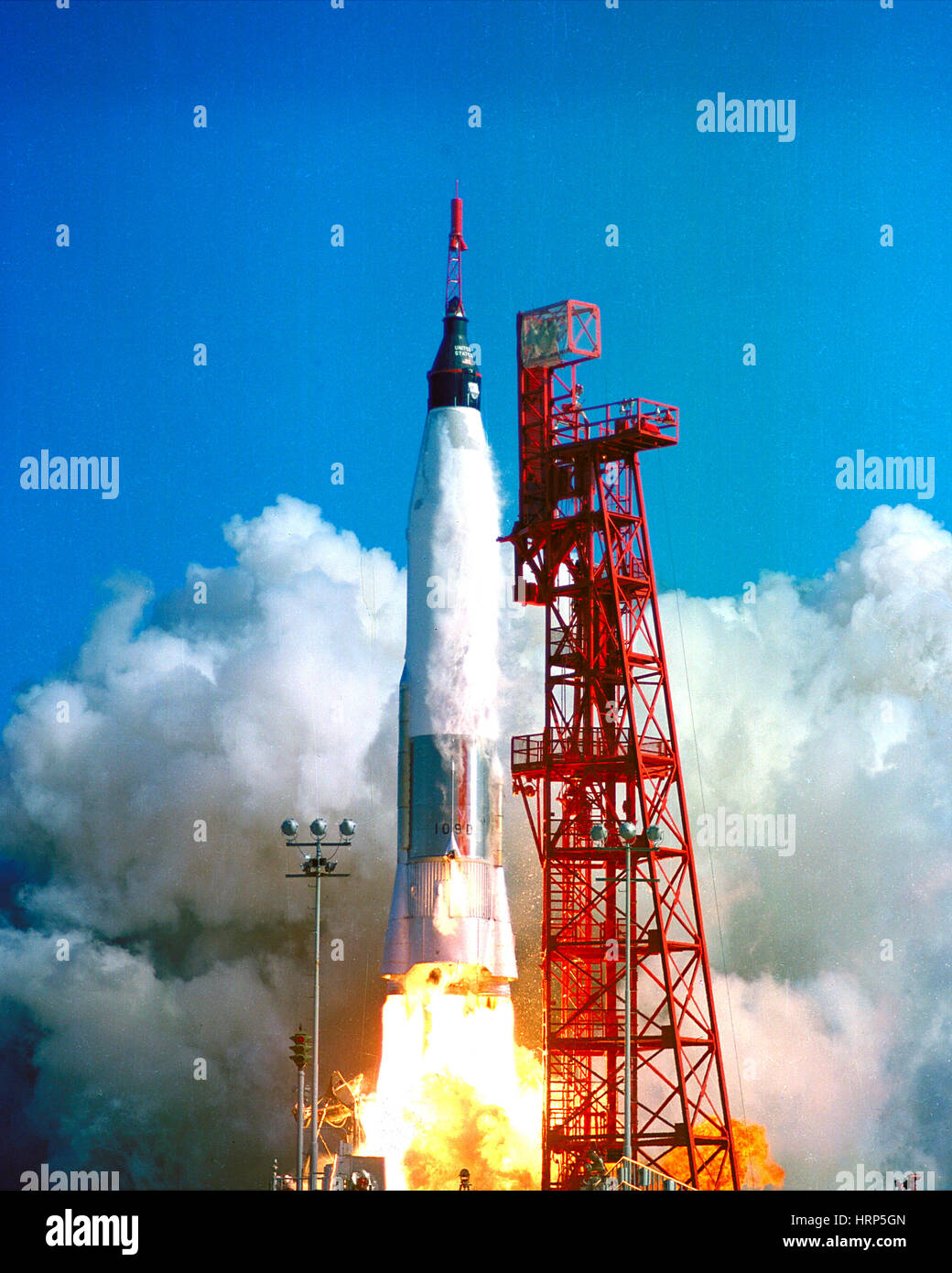 Friendship 7 Mercury-Atlas Launch, 1962 Stock Photohttps://www.alamy.com/image-license-details/?v=1https://www.alamy.com/stock-photo-friendship-7-mercury-atlas-launch-1962-135096997.html
Friendship 7 Mercury-Atlas Launch, 1962 Stock Photohttps://www.alamy.com/image-license-details/?v=1https://www.alamy.com/stock-photo-friendship-7-mercury-atlas-launch-1962-135096997.htmlRMHRP5GN–Friendship 7 Mercury-Atlas Launch, 1962
 Mercury-Atlas launch--'Mercury binder; 67D; AMR 14; liftoff 15903259098 o Mercury-Atlas launch--'Mercury binder; 67D; AMR 14; liftoff Stock Photohttps://www.alamy.com/image-license-details/?v=1https://www.alamy.com/stock-photo-mercury-atlas-launch-mercury-binder-67d-amr-14-liftoff-15903259098-77338958.html
Mercury-Atlas launch--'Mercury binder; 67D; AMR 14; liftoff 15903259098 o Mercury-Atlas launch--'Mercury binder; 67D; AMR 14; liftoff Stock Photohttps://www.alamy.com/image-license-details/?v=1https://www.alamy.com/stock-photo-mercury-atlas-launch-mercury-binder-67d-amr-14-liftoff-15903259098-77338958.htmlRMEDR2HJ–Mercury-Atlas launch--'Mercury binder; 67D; AMR 14; liftoff 15903259098 o Mercury-Atlas launch--'Mercury binder; 67D; AMR 14; liftoff
 STS-95 Payload Specialist United States Senator John H. Glenn Jr. (Democrat of Ohio) gives a thumbs up on his arrival at Kennedy Space Center's Shuttle Landing Facility aboard a T-38 jet on October 26, 1998. He and other crewmembers will be making final preparations for launch, targeted for liftoff at 2 p.m. on October 29, 1998. The STS-95 mission includes research payloads such as the Spartan solar-observing deployable spacecraft, the Hubble Space Telescope Orbital Systems Test Platform, the International Extreme Ultraviolet Hitchhiker, as well as the SPACEHAB single module with experiments o Stock Photohttps://www.alamy.com/image-license-details/?v=1https://www.alamy.com/stock-photo-sts-95-payload-specialist-united-states-senator-john-h-glenn-jr-democrat-128238052.html
STS-95 Payload Specialist United States Senator John H. Glenn Jr. (Democrat of Ohio) gives a thumbs up on his arrival at Kennedy Space Center's Shuttle Landing Facility aboard a T-38 jet on October 26, 1998. He and other crewmembers will be making final preparations for launch, targeted for liftoff at 2 p.m. on October 29, 1998. The STS-95 mission includes research payloads such as the Spartan solar-observing deployable spacecraft, the Hubble Space Telescope Orbital Systems Test Platform, the International Extreme Ultraviolet Hitchhiker, as well as the SPACEHAB single module with experiments o Stock Photohttps://www.alamy.com/image-license-details/?v=1https://www.alamy.com/stock-photo-sts-95-payload-specialist-united-states-senator-john-h-glenn-jr-democrat-128238052.htmlRMHCHMXC–STS-95 Payload Specialist United States Senator John H. Glenn Jr. (Democrat of Ohio) gives a thumbs up on his arrival at Kennedy Space Center's Shuttle Landing Facility aboard a T-38 jet on October 26, 1998. He and other crewmembers will be making final preparations for launch, targeted for liftoff at 2 p.m. on October 29, 1998. The STS-95 mission includes research payloads such as the Spartan solar-observing deployable spacecraft, the Hubble Space Telescope Orbital Systems Test Platform, the International Extreme Ultraviolet Hitchhiker, as well as the SPACEHAB single module with experiments o
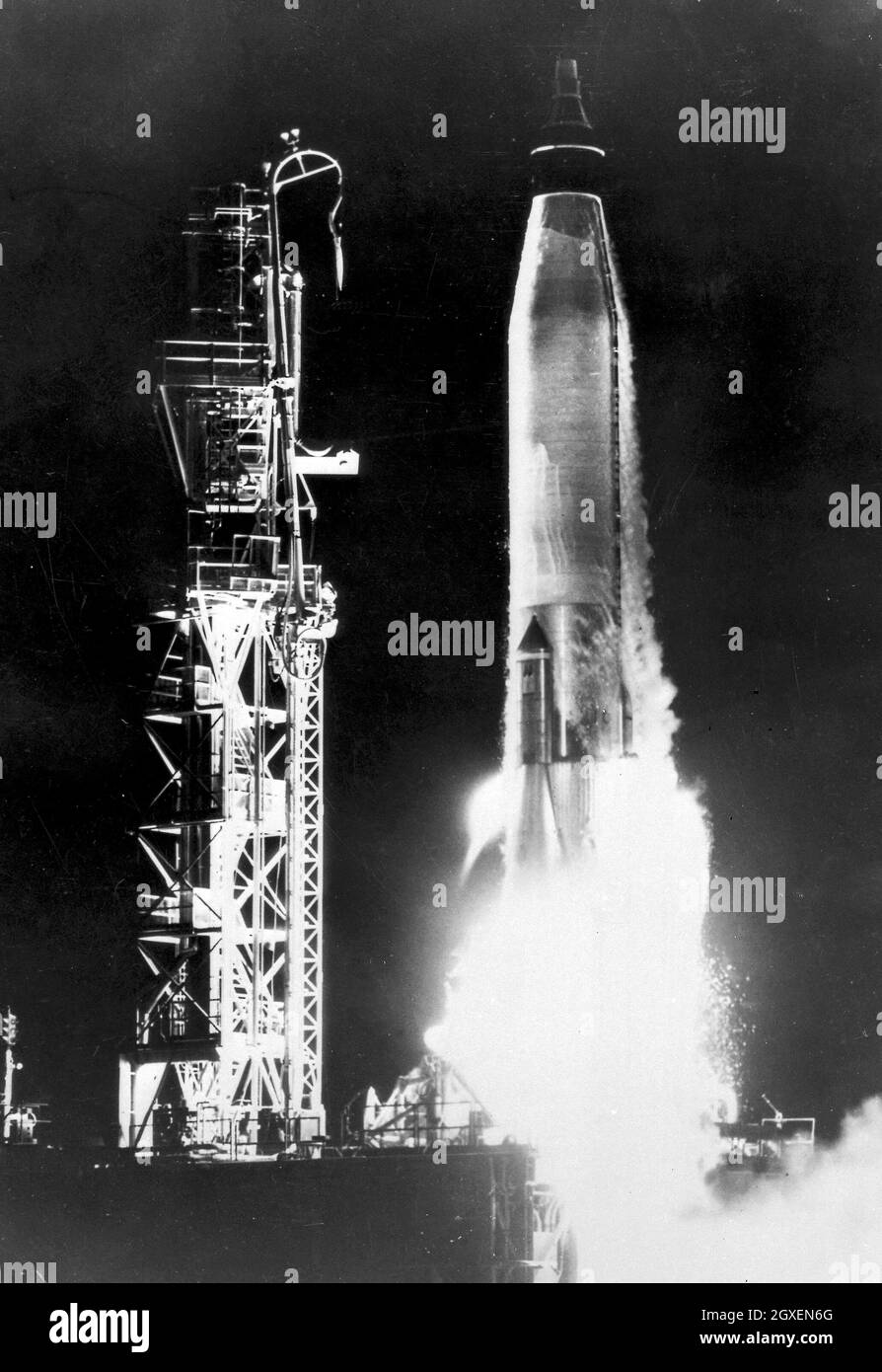 AN ATLAS LAUNCH VEHICLE CARRYING THE BIG JOE CAPSULE LEAVES ITS LAUNCH PAD ON A 2,000 MILE BALLISTIC FLIGHT TO ALTITUDES OF 100 MILES. THE BIG JOE CAPSULE IS A BOILERPLATE MODEL OF THE MANNED ORBITAL CAPSULE UNDER DEVELOPMENT BY NASA UNDER ITS PROJECT MERCURY. THE CAPSULE WAS RECOVERED AND STUDIED FOR THE EFFECT OF RE-ENTRY HEAT AND OTHER FLIGHT STRESSES. Stock Photohttps://www.alamy.com/image-license-details/?v=1https://www.alamy.com/an-atlas-launch-vehicle-carrying-the-big-joe-capsule-leaves-its-launch-pad-on-a-2000-mile-ballistic-flight-to-altitudes-of-100-miles-the-big-joe-capsule-is-a-boilerplate-model-of-the-manned-orbital-capsule-under-development-by-nasa-under-its-project-mercury-the-capsule-was-recovered-and-studied-for-the-effect-of-re-entry-heat-and-other-flight-stresses-image446564232.html
AN ATLAS LAUNCH VEHICLE CARRYING THE BIG JOE CAPSULE LEAVES ITS LAUNCH PAD ON A 2,000 MILE BALLISTIC FLIGHT TO ALTITUDES OF 100 MILES. THE BIG JOE CAPSULE IS A BOILERPLATE MODEL OF THE MANNED ORBITAL CAPSULE UNDER DEVELOPMENT BY NASA UNDER ITS PROJECT MERCURY. THE CAPSULE WAS RECOVERED AND STUDIED FOR THE EFFECT OF RE-ENTRY HEAT AND OTHER FLIGHT STRESSES. Stock Photohttps://www.alamy.com/image-license-details/?v=1https://www.alamy.com/an-atlas-launch-vehicle-carrying-the-big-joe-capsule-leaves-its-launch-pad-on-a-2000-mile-ballistic-flight-to-altitudes-of-100-miles-the-big-joe-capsule-is-a-boilerplate-model-of-the-manned-orbital-capsule-under-development-by-nasa-under-its-project-mercury-the-capsule-was-recovered-and-studied-for-the-effect-of-re-entry-heat-and-other-flight-stresses-image446564232.htmlRM2GXEN6G–AN ATLAS LAUNCH VEHICLE CARRYING THE BIG JOE CAPSULE LEAVES ITS LAUNCH PAD ON A 2,000 MILE BALLISTIC FLIGHT TO ALTITUDES OF 100 MILES. THE BIG JOE CAPSULE IS A BOILERPLATE MODEL OF THE MANNED ORBITAL CAPSULE UNDER DEVELOPMENT BY NASA UNDER ITS PROJECT MERCURY. THE CAPSULE WAS RECOVERED AND STUDIED FOR THE EFFECT OF RE-ENTRY HEAT AND OTHER FLIGHT STRESSES.
 Faith 7 Mercury-Atlas Launch, 1963 Stock Photohttps://www.alamy.com/image-license-details/?v=1https://www.alamy.com/stock-photo-faith-7-mercury-atlas-launch-1963-135097005.html
Faith 7 Mercury-Atlas Launch, 1963 Stock Photohttps://www.alamy.com/image-license-details/?v=1https://www.alamy.com/stock-photo-faith-7-mercury-atlas-launch-1963-135097005.htmlRMHRP5H1–Faith 7 Mercury-Atlas Launch, 1963
 Mercury-Atlas launch--'Mercury binder; 93D; liftoff; cx14 (launch complex 14); 15471028313 o Mercury-Atlas launch--'Mercury binder; 93D; liftoff; cx14 (launch complex 14?); Stock Photohttps://www.alamy.com/image-license-details/?v=1https://www.alamy.com/stock-photo-mercury-atlas-launch-mercury-binder-93d-liftoff-cx14-launch-complex-77338964.html
Mercury-Atlas launch--'Mercury binder; 93D; liftoff; cx14 (launch complex 14); 15471028313 o Mercury-Atlas launch--'Mercury binder; 93D; liftoff; cx14 (launch complex 14?); Stock Photohttps://www.alamy.com/image-license-details/?v=1https://www.alamy.com/stock-photo-mercury-atlas-launch-mercury-binder-93d-liftoff-cx14-launch-complex-77338964.htmlRMEDR2HT–Mercury-Atlas launch--'Mercury binder; 93D; liftoff; cx14 (launch complex 14); 15471028313 o Mercury-Atlas launch--'Mercury binder; 93D; liftoff; cx14 (launch complex 14?);
 STS-95 Payload Specialist John H. Glenn Jr., United States Senator from Ohio, reaches to embrace his wife, Annie, after landing at Kennedy Space Center's Shuttle Landing Facility aboard a T-38 jet on October 26, 1998. Behind the couple is the mate/demate device used to raise and lower the orbiter from its shuttle carrier aircraft during ferry operations. Glenn and other crew members flew into KSC to make final preparations for launch. Targeted for liftoff at 2 p.m. on October 29, 1998, the STS-95 mission includes research payloads such as the Spartan solar-observing deployable spacecraft, the Stock Photohttps://www.alamy.com/image-license-details/?v=1https://www.alamy.com/stock-photo-sts-95-payload-specialist-john-h-glenn-jr-united-states-senator-from-128237990.html
STS-95 Payload Specialist John H. Glenn Jr., United States Senator from Ohio, reaches to embrace his wife, Annie, after landing at Kennedy Space Center's Shuttle Landing Facility aboard a T-38 jet on October 26, 1998. Behind the couple is the mate/demate device used to raise and lower the orbiter from its shuttle carrier aircraft during ferry operations. Glenn and other crew members flew into KSC to make final preparations for launch. Targeted for liftoff at 2 p.m. on October 29, 1998, the STS-95 mission includes research payloads such as the Spartan solar-observing deployable spacecraft, the Stock Photohttps://www.alamy.com/image-license-details/?v=1https://www.alamy.com/stock-photo-sts-95-payload-specialist-john-h-glenn-jr-united-states-senator-from-128237990.htmlRMHCHMT6–STS-95 Payload Specialist John H. Glenn Jr., United States Senator from Ohio, reaches to embrace his wife, Annie, after landing at Kennedy Space Center's Shuttle Landing Facility aboard a T-38 jet on October 26, 1998. Behind the couple is the mate/demate device used to raise and lower the orbiter from its shuttle carrier aircraft during ferry operations. Glenn and other crew members flew into KSC to make final preparations for launch. Targeted for liftoff at 2 p.m. on October 29, 1998, the STS-95 mission includes research payloads such as the Spartan solar-observing deployable spacecraft, the
 ***FILE PHOTO*** Annie Glenn, wife of John Glenn, Has Passed Away Of COVID-19 Complications. STS-95 Payload Specialist John H. Glenn Jr., United States Senator from Ohio, reaches to embrace his wife, Annie, after landing at Kennedy Space Center's Shuttle Landing Facility aboard a T-38 jet on October 26, 1998. Behind the couple is the mate/demate device used to raise and lower the orbiter from its shuttle carrier aircraft during ferry operations. Glenn and other crew members flew into KSC to make final preparations for launch. Targeted for liftoff at 2 p.m. on October 29, 1998, the STS-95 miss Stock Photohttps://www.alamy.com/image-license-details/?v=1https://www.alamy.com/file-photo-annie-glenn-wife-of-john-glenn-has-passed-away-of-covid-19-complications-sts-95-payload-specialist-john-h-glenn-jr-united-states-senator-from-ohio-reaches-to-embrace-his-wife-annie-after-landing-at-kennedy-space-centers-shuttle-landing-facility-aboard-a-t-38-jet-on-october-26-1998-behind-the-couple-is-the-matedemate-device-used-to-raise-and-lower-the-orbiter-from-its-shuttle-carrier-aircraft-during-ferry-operations-glenn-and-other-crew-members-flew-into-ksc-to-make-final-preparations-for-launch-targeted-for-liftoff-at-2-pm-on-october-29-1998-the-sts-95-miss-image358175241.html
***FILE PHOTO*** Annie Glenn, wife of John Glenn, Has Passed Away Of COVID-19 Complications. STS-95 Payload Specialist John H. Glenn Jr., United States Senator from Ohio, reaches to embrace his wife, Annie, after landing at Kennedy Space Center's Shuttle Landing Facility aboard a T-38 jet on October 26, 1998. Behind the couple is the mate/demate device used to raise and lower the orbiter from its shuttle carrier aircraft during ferry operations. Glenn and other crew members flew into KSC to make final preparations for launch. Targeted for liftoff at 2 p.m. on October 29, 1998, the STS-95 miss Stock Photohttps://www.alamy.com/image-license-details/?v=1https://www.alamy.com/file-photo-annie-glenn-wife-of-john-glenn-has-passed-away-of-covid-19-complications-sts-95-payload-specialist-john-h-glenn-jr-united-states-senator-from-ohio-reaches-to-embrace-his-wife-annie-after-landing-at-kennedy-space-centers-shuttle-landing-facility-aboard-a-t-38-jet-on-october-26-1998-behind-the-couple-is-the-matedemate-device-used-to-raise-and-lower-the-orbiter-from-its-shuttle-carrier-aircraft-during-ferry-operations-glenn-and-other-crew-members-flew-into-ksc-to-make-final-preparations-for-launch-targeted-for-liftoff-at-2-pm-on-october-29-1998-the-sts-95-miss-image358175241.htmlRM2BPM84W–***FILE PHOTO*** Annie Glenn, wife of John Glenn, Has Passed Away Of COVID-19 Complications. STS-95 Payload Specialist John H. Glenn Jr., United States Senator from Ohio, reaches to embrace his wife, Annie, after landing at Kennedy Space Center's Shuttle Landing Facility aboard a T-38 jet on October 26, 1998. Behind the couple is the mate/demate device used to raise and lower the orbiter from its shuttle carrier aircraft during ferry operations. Glenn and other crew members flew into KSC to make final preparations for launch. Targeted for liftoff at 2 p.m. on October 29, 1998, the STS-95 miss
